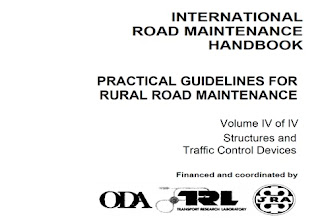International Road Maintenance Handbook 4
 |
| International Road Maintenance Handbook 4 |
| INTERNATIONAL ROAD MAINTENANCE HANDBOOK 4 | |
|---|---|
| Bahasa | : Inggris |
| Halaman | : 171 Halaman |
| Format | |
| Sumber | : - |
| Sifat | : GRATIS |
| Download | |
EBOOK CONTENTS
VOLUME III - MAINTENANCE OF STRUCTURES AND TRAFFIC CONTROL DEVICES
This volume describes the maintenance of bridges (Part A), and traffic control devices (Part B). The objective of bridge maintenance is to keep the structures in sound condition and safe for traffic.
Where a bridge spans a watercourse, the water must flow freely at all flood levels without damaging the bridge or the waterway.
The objective of traffic control device maintenance is to keep all signs, guide posts, markings and barriers in a good condition so that they fulfil their function. This will keep road users informed and help to make their travel as safe as possible.
Part A - Bridges
Routine and Periodic Maintenance activities are described which can be carried out by a gang without specialist skills or equipment. Major structural repairs are beyond the scope of this handbook and require specific skills for identification and remedy.
Part B - Traffic Control Devices
The necessary activities for cleaning, repair and replacement of traffic control devices are described. Details of the standard temporary signs required for road maintenance works are provided.
DEFECTS
Defects in bridges should be detected early and repaired promptly. If they are neglected the resulting damage will usually require more extensive repairs or even lead to the collapse of the structure.
LIST OF DEFECTS
In order to properly remedy a bridge defect, its cause must be assessed. Only when the cause is known, is it possible to successfully cure the problem.
On the following pages commonly occurring defects are shown. Their probable causes are given together with a suggested maintenance activity. In addition the results of neglected repair are mentioned:
MINOR DEFECTS
1. Minor Defects (Non structural)
- Accumulation of dirt and soil on bridge deck*
- Blocked scuppers*
- Stones, soil, dirt in joints and around bearings
- Vegetation, soil in weep holes or in backfill drainage* outlets
- Flood debris at or under bridge
- Wind blown debris on or under bridge.
Main Causes
Poor routine maintenance. Development, if neglected
- Slippery road surface when wet, accidents
- Ponding of water on bridge deck, water penetrates and attacks structure, accidents
- Bridge deck cannot expand or contract as designed, structural damage
- Water cannot drain and backfill may settle, abutment* may move under pressure
- Waterway opening becomes smaller, pressure build up on piers/deck in floods, roadway floods, fire hazard in dry season
- Accidents, waterway opening becomes smaller.
Remedies
Cleaning/clearing.
2. Minor Defects (Structural)
- Loose or missing nailed/bolted connectors or fixings
- Damaged running boards and deck planks
- Rusty steel, faded paint
- Untreated wood
- Defective masonry joints.
Main Causes
- Loss or loosening through age, action of traffic, rust, or poor workmanship
- Action of traffic, water, decay
- Weathering
- Lack of wood-preservation treatment
- Settlement, poor construction.
Development, if neglected
- Loss of planking and railing; weakened truss, damage to vehicle tyres
- Loss of planking
- Corrosion of steel member
- Loss of wood member by fungus or insect attack
- Local collapse of masonry structure.
Remedies
Minor Repairs (Structural)
- Repair of loose or missing connectors or fixings
- Replace defective planks
- Painting
- Wood preservation
- Pointing masonry.
3. Minor Defects (Safety)
- Damaged safety barrier or parapet*
- Damaged warning signs
Main Causes
- Accident damage
- Accident damage, weathering
Development, if neglected
- Reduced safety for bridge users
- Reduced safety for bridge users
Remedies
- Repair barrier or parapet
- Repair or replace warning signs
MAJOR DEFECTS
All major defects must be brought to the attention of, and inspected by, the Bridge Engineer or Inspector.
This Handbook deals only with the more straight forward major repairs relating to stream bed or bank erosion:
- random stone filling
- retaining wall
- riverbed scour apron
- gabions.
For any of the following defects the Bridge Inspector or Engineer must be informed, investigate and arrange detailed plans for appropriate remedies.
- structural timber decay, splitting or insect attack
- bulging masonry
- cracked concrete or masonry
- honeycombed concrete
- spalling concrete
- serious rust or chemical stains
- exposed or corroding reinforcement, or prestressing steel
- damp patches on the concrete
- seriously corroded structural steelwork
- damaged/distorted structural steelwork
- loose structural rivets, bolts or other fixings
- cracks in structural steelwork
- settlement of deck, piers or abutments
- erosion requiring piling works
- repairs to steel panel bridges (e.g. Bailey).





Post a Comment for "International Road Maintenance Handbook 4"